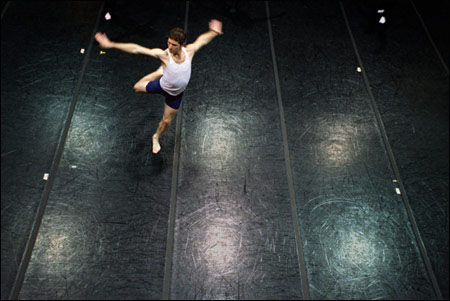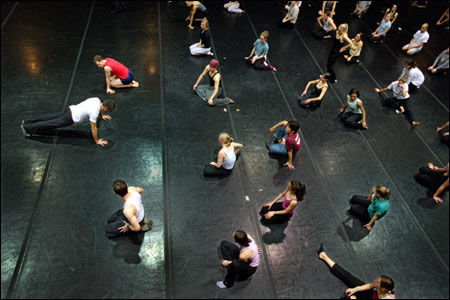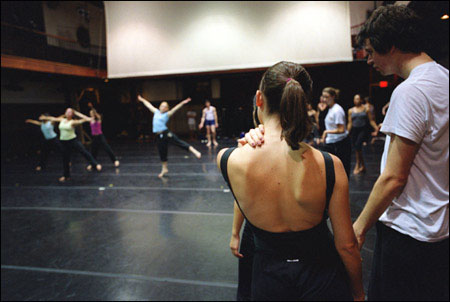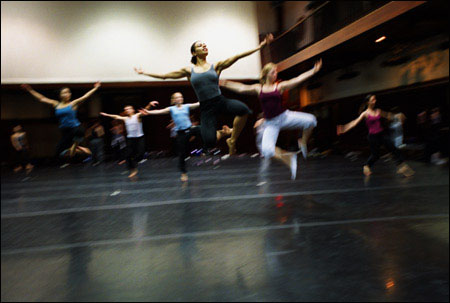Paul Taylor Dancers bring signature style to Harvard:
Master class, lecture-demonstration thrill student dancers

As the music swelled, dozens of dancers arched and twisted, contracted and spiraled; their arms raised heavenward, feet planted in a wide, earthy stance.
“Find the round place,” coached Kenneth Tosti from the front of the room as he hollowed his abdomen with a deep contraction. “Don’t try to be perfect, if that’s your thing.”
Yet the dancers were perfect, swaying in graceful unison with a focused concentration and almost prayerful energy.
And that was just the warm-up.
Tosti, a former dancer with the acclaimed Paul Taylor Dance Company, and the six dancers who comprise the Taylor 2 touring company brought Taylor’s lyrical, athletic, playful style to Harvard Tuesday (Nov. 12) for a master class and lecture-demonstration performance. The residency, co-sponsored by the Office for the Arts’ Dance Program and Learning from Performers, filled the Rieman Center for the Performing Arts with a palpable energy as the Harvard dancers moved shoulder-to-shoulder with the professionals.

“A master class gets the students to appreciate the way they’re moving and to think about the way they’re moving,” said Dance Program director Elizabeth Bergmann, who hosts several classes with guest master teachers each semester. “For them, it’s as impactful as a great lecture.”
In the master class, Tosti imparted solid technical training with flourishes of Taylor’s choreography.
“Go down to go up,” he said as he led the class in pliés, the very elegant knee bends that are a foundation of both modern dance and ballet. “If you can understand the plié, you can change your dancing,” he added.
As the class escalated from warm-up to impromptu partnering to ecstatic leaps and runs that launched dancers, airborne, across the studio, Tosti challenged the students to consider the three elements of choreography: shape, rhythm or musicality, and dynamic.
Exploring the latter, dancers flowed through an exercise then imposed a jerky, staccato style on the same set of movements. “You have to show me a still moment,” instructed Tosti, “but keep the still moment alive.”
Then they “scribbled”: Dancers wiggled and jerked, flowed and posed like hyperkinetic marionettes.
Feeling this range of dynamics is crucial, said Tosti, “so you can be all these different colors, not just be so many that you are brown.”
Gleeful from finishing the class with joyous, rhythmically challenging leaps, the Harvard dancers – who ranged in ability from near-novice to a few indistinguishable from the professionals – chorused “That was awesome” from around the studio.
“It was fantastic,” said Kristin Ing, a student at the Graduate School of Education. “He had so many wonderful ideas about movement and energy and intention.”
Although her solid ballet training makes her at home with Taylor’s classical, ballet-based movement, Jetta Martin ’05 welcomed the opportunity to dispense with perfection. “I liked the focus on the intent and the feeling rather than the technique,” she said.

From class to concert
Several hours later, with the Rieman Center transformed from studio to performance space and the Harvard dancers settled into the sold-out audience, Tosti served as emcee and expert as Taylor 2 demonstrated why Paul Taylor’s choreography has endured and flourished for nearly 50 years.
The performance featured excerpts from dances that spanned Taylor’s career, from his signature 1962 “Aureole” to the character-driven nostalgia of “Company B” (1991) to 1997’s tango-inspired “Piazzolla Caldera.”
The evening’s works complemented the afternoon’s class as neatly as thoughtful curriculum. The 1979 work “Profiles,” with its geometric gymnastics, extended the percussive, angular dynamic Tosti explored. And in “Aureole,” the students saw elements of their warm-up flow into one of Taylor’s most iconic solos.
“For a man to come out center stage in white and do a very lyrical solo for four and a half minutes was a pretty brave and bold thing for 1962,” Tosti told the audience in the casual remarks he made as the dancers changed costumes and caught their breath offstage.
In the 1975 dance “Esplanade,” the music of J.S. Bach lent a courtly demeanor to Taylor’s meditation of the everyday movements of walking, running, and gesturing. Tosti pointed out that “Company B,” set to the music of the Andrews Sisters, evokes the social dance styles of the World War II era without ever breaking into lindy steps.
The small space, pared-down company (the full-throttle Paul Taylor Dance Company numbers 16), and informal but informative remarks by Tosti made for an intimate evening, and audience members asked about Taylor, the dancers’ lives, and the choreographic process.
Before dancing, Paul Taylor was a painter and a swimmer, said Tosti, and he brings elements of both to his work. While he is a very disciplined artist, Tosti said that Taylor rarely enters the studio with a dance fully formed; rather, he’ll bring musical and choreographic ideas to his dancers and work with them to create the movement.

“A dance is alive, it’s a living thing,” said Tosti. “The dance doesn’t exist except for the dancers who do it.”




